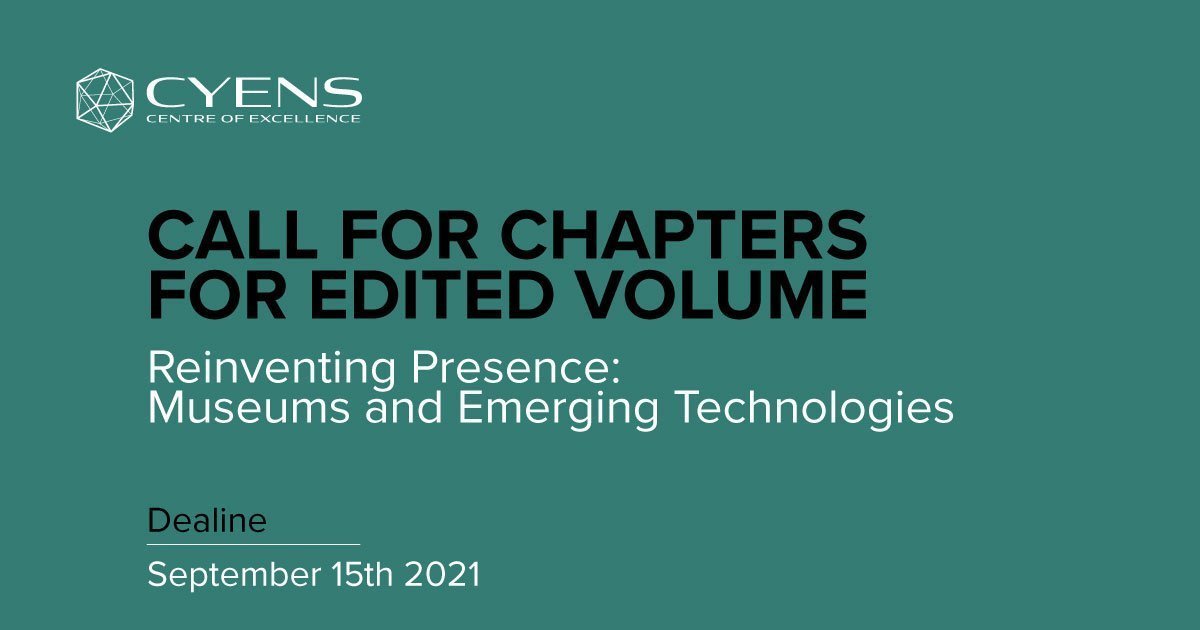Reinventing Presence: Museums and Emerging Technologies
Deadline: September 15th 2021
This edited volume, with the working title “Reinventing Presence: Museums and Emerging Technologies” examines theoretical approaches and case studies that explore how this ‘presence culture’ can also be applied both in museum spaces and virtual experiences, where visitors engage with objects and virtual exhibitions in real time, multisensory, and embodied ways and what role technology can play in this. Although the introduction of technology has been criticized for disturbing this sense of presence in museum spaces, it has also been praised for offering new, immersive and embodied experiences. Experiences that have the potential to reinvent presence.
We are particularly interested in the theoretical underpinnings of the concept of ‘presence’ for museum spaces and the critical examination of how immersive and other emerging technologies such as virtual reality, interactive (multisensory) installations/rooms, holograms, other innovative screen-less technologies, AI and deep fakes, can affect – diminish or enhance – our sense of presence and embodiment. We are also interested in the different aspects relating to ‘presence culture’ and technology such as immersion, embodiment, authenticity/aura, empathy, imagination, emotion, engagement, education, affect, and creativity.
Key questions of the edited volume are: how can technology move away from providing information to facilitating our sense of presence, enriching our affective responses or connecting us with authentic objects? Can technology facilitate the incorporation of a new presence culture in museums? How can museums potentially focus on the embodiment capabilities of technology and on offering multisensory experiences that can generate empathy, historical presence and a sense of personal growth? Can technology act as a distraction in museums, affecting the visitors’ sense of presence? How can technological solutions be conceived as immersive vehicles of embodiment and presence? Finally, what are the ethical and other issues that result from such practices?
Apart from the above questions, topics could also include – but are not limited to:
- Theoretical underpinnings of presence/presence philosophies in museum studies in view of new technological developments (ex. meaning and presence, representational and non-representational, metonymy and metaphor, metonymically induced presence)
- Innovative interactive/multisensory installations and other embodied technological experiences
- Advantages, challenges and limitations of using emerging technologies for enhancing presence
- Different aspects of presence: authenticity/aura, empathy, imagination, emotion, engagement, education, affect, and creativity
- Spatio-temporal presence in museum environments
- Technologically-assisted sensory engagement of visitors
- The role of presence and atmosphere in the dynamics of the museum experience
- Absent presence
- Nostalgia, memory and presence in museum exhibitions
- Deep nostalgia, AI and deep fakes
- Relation between presence and immersion
- Affect, empathy and presence
- Aesthetics of presence/art and presence
- Presence through avatars/virtual museums
- Evaluation studies of specific applications of technologies used for enhancing a sense of presence
- Application of presence practices in different types of museums
- Education/museum pedagogy through technology-enhanced presence
- Case studies of exhibitions focusing on presence and multisensory experiences
- Other themes related to the key questions of the call
The volume will be edited by Dr Maria Shehade (CYENS Centre of Excellence) and Dr Theopisti Stylianou-Lambert (Cyprus University of Technology/ CYENS Centre of Excellence) and will be published by a well-known academic publisher.
To submit your chapter proposal please send a 500-word abstract (including references) and a short bio for each author (up to 70 words each) to m.shehade@cyens.org.cy by September 15th 2021. The selected authors will be expected to deliver a full paper (length: 6000- 8000 words) by February 14th 2022.

